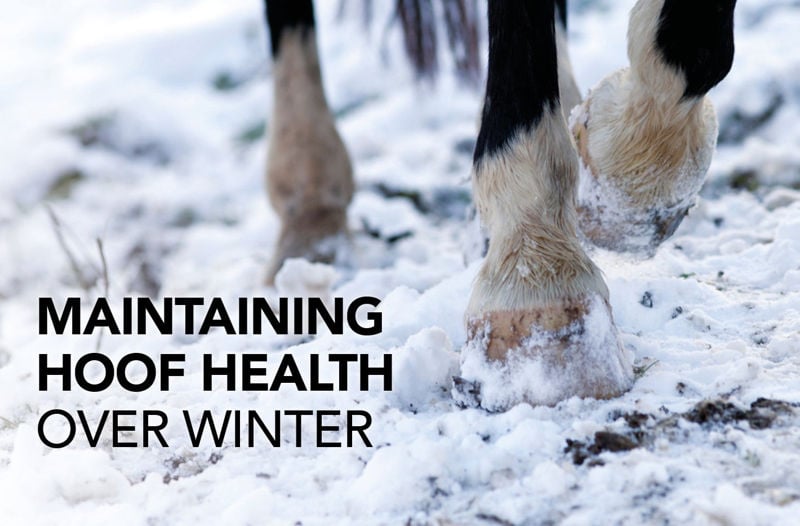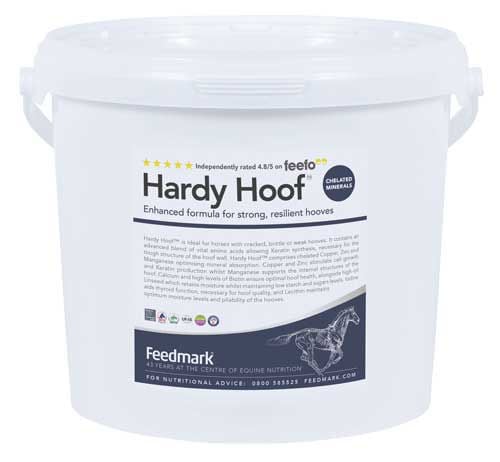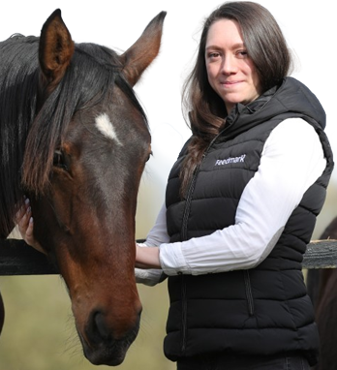Hoof growth slows over winter (Lewis et al. 2014; He et al. 2020), likely due to the horses’ hormones switching to "energy-saving mode" over the winter months (Frackowiak and Komosa, 2006). However, despite hoof growth slowing it is still important to regularly check your horses’ hooves for signs of issues that are more common in winter. Three of the most common hoof issues over winter months are thrush, bruising and abscesses.
Thrush
Thrush is a bacterial infection of the tissues of the frog, that occurs when bacteria penetrates the epidermis of the frog, (Petrov and Dicks, 2012). It is a common issue during wet winters and symptoms include black fluid leaking from the frog, combined with a foul, strong smell (Redding and O'Grady, 2012). In severe cases the bacteria can reach the sensitive tissue beneath the frog, causing pain and lameness (O’Grady, 2018). If your horse is suffering from thrush your farrier will be able to cut away the infected tissue and apply a product to kill the organisms.
To help reduce the risk of thrush -
- Frequently pick out hooves.
- Ensure hooves are regularly allowed to dry out.
- Keep stables clean (wet bedding can harbour bacteria).
- Keep up with regular farriery (Unbalanced hooves are at a higher risk of developing thrush)
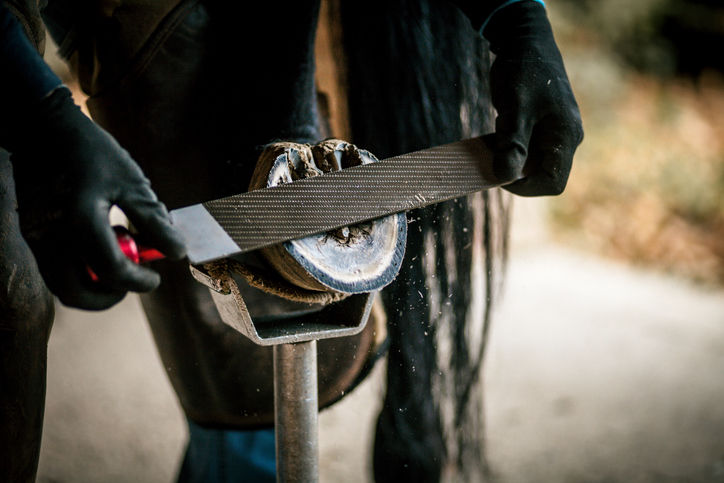
Regular farriery is a must in winter to keep hooves balanced
Bruising
Bruised soles are another common problem seen in the winter months. Bruised soles are often seen when the weather turns cold leading to wet, boggy ground freezing and becoming rutted. The risk of bruising is increased following wet weather as wet conditions lead to softer soles (McGoldrick, 2022). Snowy weather is another time when bruising is more common as snowballs build up in the hooves of shod horses. When these snowballs freeze they become hard which can cause bruising (Pownall, 2023). Bruising can cause mile to severe lameness and can also develop into an abscess which can cause various degrees of lameness if left untreated. (DeBowes and Yovich, 1989; Abidina et al. 2013).
To reduce the risk of bruising -
- Don’t work horses on frozen ground or in hard or frozen arenas.
- If possible smooth out rutted ground in fields before it freezes.
- Consider adding protective padding to shoeing or using hoof boots.
- Remove snowballs from hooves when they build up.
- Apply a hoof dressing to improve overall hoof quality.
- Feed a supplement to improve hoof quality if needed.
- Walkways can be made gentler (and less slippery) with regular applications of sand, shavings or non-clumping cat litter.
In winter boggy ground can freeze into hard ruts and bruise hooves. Snow is an added hazrd as it packs hard into the sole.
Abscess
Hoof abscesses are one of the most common reasons for acute, severe lameness in horses (Cole et al. 2019) and are a common reason for veterinary or farrier call outs in the winter months. Abscesses occur when foreign matter (such as gravel, dirt, sand and manure coupled with bacteria or fungal elements) invade the hoof capsule via a wound in the outer layer of the hoof (O’Grady, 2003). Once the bacteria works its way to the inner tissues of the hoof it multiples and produces a painful abscess (pocket of pus), causing acute lameness (McGoldrick, 2022).
To help reduce the risk of abscesses -
- Pick out feet before and after turnout.
- Allow periods of time where the hooves are able to dry out.
- Ensure that fresh, clean bedding is regularly provided.
- Provide a dry standing area in fields to allow relief from wet conditions.
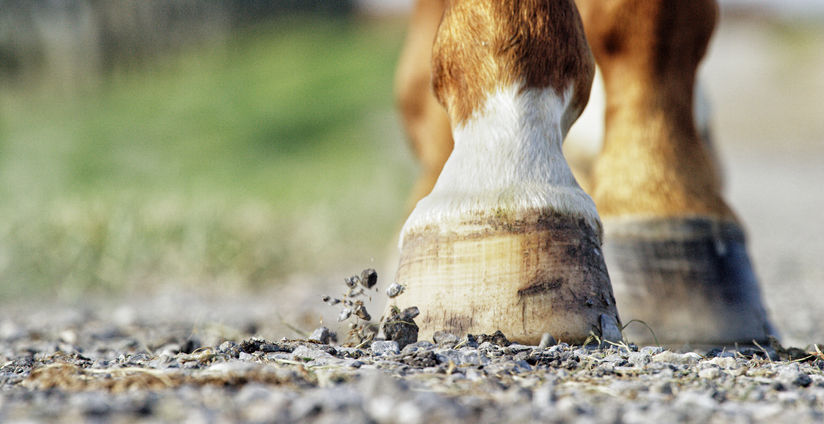
Hoof with damage from old abscess
To help support optimal hoof health over the winter months consider supplementing with a hoof supplement, such as Feedmark Hardy Hoof™.
Hardy Hoof™ is ideal for horses with cracked, brittle or weak hooves. It contains an advanced blend of vital amino acids allowing Keratin synthesis, necessary for the tough structure of the hoof wall. Hardy Hoof™ comprises chelated Copper, Zinc and Manganese optimising mineral absorption. Copper and Zinc stimulate cell growth and Keratin production whilst Manganese supports the internal structures of the hoof. Calcium and high levels of Biotin ensure optimal hoof health, alongside high-oil Linseed which retains moisture whilst maintaining low starch and sugar levels. Iodine aids thyroid function, necessary for hoof quality and Lecithin maintains optimum moisture level and pliability of hooves. Read more about the science behind Hardy Hoof™ here >>
References
- Abidina, N.S.Z., Adamua, L. and Ahmada, B. (2013) ‘Incidence of equine hoof derangements in Malaysian horse population.’, Journal of Agriculture and Veterinary Sciences, 5, pages 26-3
- Cole, S.D., Stefanovski, D., Towl, S. and Boyle, A.G. (2019) ‘Factors associated with prolonged treatment days, increased veterinary visits and complications in horses with subsolar abscesses. Veterinary Record’, 184(8), pages 251-251.
- DeBowes, R.M. and Yovich, J.V. (1989) ‘Penetrating wounds, abscesses, gravel, and bruising of the equine foot.’, Veterinary Clinics of North America: Equine Practice, 5(1), pages 179-194.
- Frackowiak, H. and Komosa, M. (2006) ‘The dynamics of hoof growth of the primitive Konik horses (Equus caballus gmelini Ant.) in an annual cycle.’, Biological Rhythm Research, 37(3), pages 223-232.
- He, Y., Nadeau, J., Reed, S., Hoagland, T., Bushmich, S., Aborn, S., Jones, A.K. and Martin, D. (2020) ‘The effect of season on muscle growth, fat deposition, travel patterns, and hoof growth of domestic young horses.’, Journal of equine veterinary science, 85, pages 102817.
- Lewis, C., Nadeau, J., Hoagland, T. and Darre, M. (2014) ‘Effect of season on travel patterns and hoof growth of domestic horses.’, Journal of Equine Veterinary Science, 34(7), pages 918-922.
- McGoldrick, N. (2022) Plan your Winter Hoof Care Strategy Now’, Available at https://absorbine.co.uk/plan-your-winter-hoof-care-strategy-now/ [Accessed 6th November 2023]
- O’Grady, 2. (2012) ‘Equine Thrush: A Closer Look’, Available at https://www.equipodiatry.com/news/Equine_Thrush_A_Closer_Look.html [Accessed 20th November 2023]
- O’Grady, S.E. (2003) Hoof abscesses. Retirado em, 4. Available at https://www.thehorseshoebarn.com/wp-content/uploads/2016/02/5229NatAngleV15Iss4November15_HORSESHOEBARN.pdf
- Petrov, K.K. and Dicks, L.M. (2013) ‘Fusobacterium necrophorum, and not Dichelobacter nodosus, is associated with equine hoof thrush.’, Veterinary microbiology, 161(3-4), pages 350-352.
- Pownall, M (2023) ‘Why Hoof Bruises Happen’, Available at https://equusmagazine.com/lameness/hoof-bruises-happen-29327/ [Accessed 17th November 2023)
- Redding, W.R.; O’Grady, S.E. (2012) ‘Nonseptic Diseases Associated with the Hoof Complex.’, Veterinary Clinics of North America: Equine Practice, 28(2), pages 416-420


